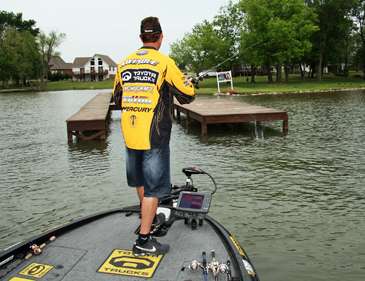
Docks are more than potential bass-harboring structures for Gerald Swindle. Rather, the Elite Series pro from Warrior, Ala., sees these fish condos as a personal challenge — a “You want some of this?” kind of deal.
That being said, he resists the urge to shock-and-awe his way into a bite, instead favoring surgical strikes heavy on the strategies of positioning and bait delivery. The plan starts with a comprehensive view of the target, which, in most cases, comprises a walkway and some form of end structure such as a T, boat shed or pavilion.
The more substantial form of a dock’s terminal end first grabs the eye, and many anglers mistakenly stop there. Swindle warns against overlooking a dock’s full potential.
“Don’t just focus on the building and ignore the highway leading to it,” he said. “That fish uses a dock just like he uses an entire creek ledge. You really need to look at all of those areas. They’re a little aggravating and hard to get to, but they can be productive.”
Noting that bass position along a dock relative to the seasons, Swindle expects to find fish at the ends in the deep, stable water during the temperature extremes of winter and summer. Fall highlights the midsections to the shoreward quarter, while spring sees spawning activity in the shallow end.
“Docks are great places for bass to spawn,” Swindle notes. “They get sun on them, they have the protection they need and they’ll spawn right up against those poles. And when their eggs hatch, their fry can hide under the docks.”
In any season, a variety of baits and tactics will tempt dock bass, but Swindle keeps it simple by skipping a 3/8-ounce Arkie jig with a green pumpkin Zoom twin tail trailer. This tactic enables him to reach well into the sweet spots, but avoid spooking the fish by staying off their doorstep.
Arming himself with a 6-foot, 10-inch Quantum Tour KVD spinnerbait rod and a 6.3:1 Quantum PT reel loaded with 20-pound fluorocarbon, Swindle aims for a spot about six inches in front of the dock. This enables the bait to make contact with the water and then flatten out before moving toward the opening.
Aiming too close increases the risk of actually hitting the dock. Doing so will stop a bait’s progress and spook the fish. Skill borne of thousands of casts allows Swindle to make it look easy, but he said anyone can learn the right presentation if they’ll trust their tackle and value precision over power.
“One thing that’s important for skipping docks is that you shouldn’t adjust your casting tension,” he said. “A lot of guys want to tighten down their reel so they don’t backlash, but you end up throwing too hard and that makes you cast too high. Use your thumb to control the tension.”
Boat positioning matters a lot in this game, and Swindle suggests staying as far away from the dock as possible while maintaining a realistic casting range.
“Boat noise, trolling motor noise and bumping around the deck will all affect the fish,” he notes. “Set up your casts from your strong side — if you’re right-handed, set up your cast that way.”
Now, if you really want to goose the G-Man’s competitive nature, put some vertical slats on that dock. Designed primarily to keep weeds and other debris from clogging the undersides, these barriers also restrict casting. For some, that’s a bad thing. For Swindle, that’s a big, red neon sign flashing “Big Bass Live Here!”
“When I identify a dock with anything nailed down in the water, it’s almost like a ‘No Trespassing’ sign,” he said. “Most fishermen would just go around that dock, but an alarm goes off in my head and that’s the one I’m just dying to throw under because those are generally the ones that are untouched.”





